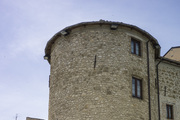
I resti della cerchia muraria oggi visibili, in opera incerta, risalgono al XIV secolo: se ne conservano tratti nei pressi di Porta Romana – a nord-ovest – e lungo l’attuale via Circonvallazione Orientale – tra Porta Napoli e Porta Pacentrana e in prossimità di Porta Japasseri – mentre nulla resta del recinto altomedievale e tantomeno di quello romano.
Delle sette porte che si...
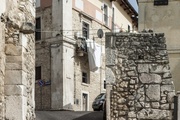
Il nome attuale della porta è la forma italianizzata dell’ originaria denominazione Johannis Bonorum Hominum, sicuramente derivata da un personaggio che aveva provveduto al suo rifacimento o che abitava nei pressi, come è stato riscontrato più volte per altre porte cittadine. Il varco si apre a nord-ovest dell’antico recinto - sull’angolo opposto a Porta Japasseri - e segnava anche l’ingresso...
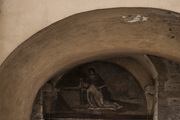
La porta si apre lungo il tratto occidentale della seconda cinta muraria, proprio in fondo alla strada che costeggia il fianco sinistro della chiesa da cui prende il nome ,e attorno alla quale, all’inizio del Trecento, si venne formando l’omonimo borgo, inserito nel perimetro dell’abitato attraverso l’ampliamento della cerchia delle mura antiche, che incluse anche gli altri borghi sorti nel...
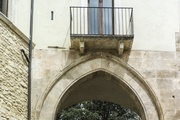
La porta è situata presso l’angolo sud-occidentale della prima cinta muraria altomedievale ed è l’unica in discreto stato di conservazione tra quelle del primitivo circuito; fu in seguito rafforzata dall’apertura di Porta Sant’Antonio, posta alla base della rampa di accesso nel più ampio recinto della seconda cerchia di mura, costruita tra la fine del Duecento e gli inizi del secolo successivo,...
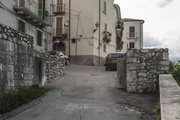
Il nome attuale della porta è la volgarizzazione della originaria denominazione Johannis Passarum, sicuramente derivata da un personaggio che aveva provveduto al suo rifacimento o che vi abitava nei pressi, come è stato riscontrato più volte per altre porte cittadine. Il varco si apre a nord-est dell’antico recinto e fu il solo, insieme a Porta Bonomini, situata all’angolo opposto, a mantenere...
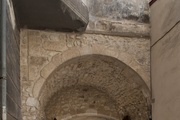
Porta Molina è situata lungo il tratto occidentale della cinta muraria altomedievale, tra le porte Bonomini e Filiamabili; era un accesso secondario o postierla, probabilmente da identificare in un primo momento con la “posterula ardengi” menzionata In un documento del 1168 contenuto nel Chronicon Casauriense, altrimenti sconosciuta, non essendo attestata un’altra porta di servizio in un...
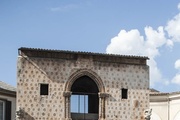
La porta sud di accesso alla città medievale era inserita nella seconda cinta muraria, edificata tra la fine del XIII e gli inizi del XIV secolo per far fronte alle nuove esigenze difensive dell’abitato urbano conseguenti all’imponente crescita demografica e all’espansione urbanistica che Sulmona aveva avuto durante il periodo della dominazione sveva (sec. XIII).
Denominata in...
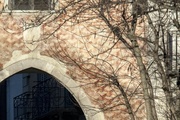
La porta si apre lungo il lato orientale della cinta muraria trecentesca - sulla strada che conduce a Pacentro, da cui il nome - e serviva il borgo omonimo. È da identificare con ogni probabilità con la Porta Orientis, come sembrerebbe dedursi dal Rituale delle Rogazioni conservato presso l’Archivio della Cattedrale di S. Panfilo che, alla carta 53, riporta la dicitura Porta Pacentrana su di...
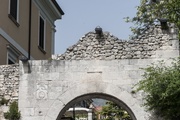
La porta era conosciuta in passato col nome di “Pinciara”, in quanto serviva l’omonimo borgo che doveva tale denominazione alle numerose fabbriche per la produzione di embrici attive in epoca medievale; la prima citazione come Porta Romana è presente nel catasto cittadino del 1376. Nel XVI secolo assunse anche il nome di Porta San Matteo, per la vicinanza alla piccola chiesa dedicata al Santo,...
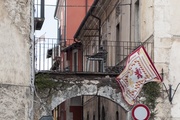
La porta si apre lungo il tratto orientale della seconda cinta muraria, che tra la fine del Duecento e l’inizio del secolo successivo estese il perimetro dell’abitato ad includere i borghi sorti a ridosso della primitiva cerchia e, nello specifico, il Borgo Pacentrano, al cui estremo meridionale è ubicato il varco. Gli studiosi non sono concordi circa la sua datazione: una tesi accoglie come...
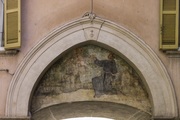
La porta si apre lungo il tratto occidentale della seconda cinta muraria, che tra la fine del Duecento e l’inizio del secolo successivo estese il perimetro dell’abitato per includere i borghi sorti a ridosso della primitiva cerchia e - nello specifico - il borgo Sant’Agata.
Essa sostituì nella funzione la Porta Filiamabili, tuttora esistente, che chiudeva il nucleo antico...










